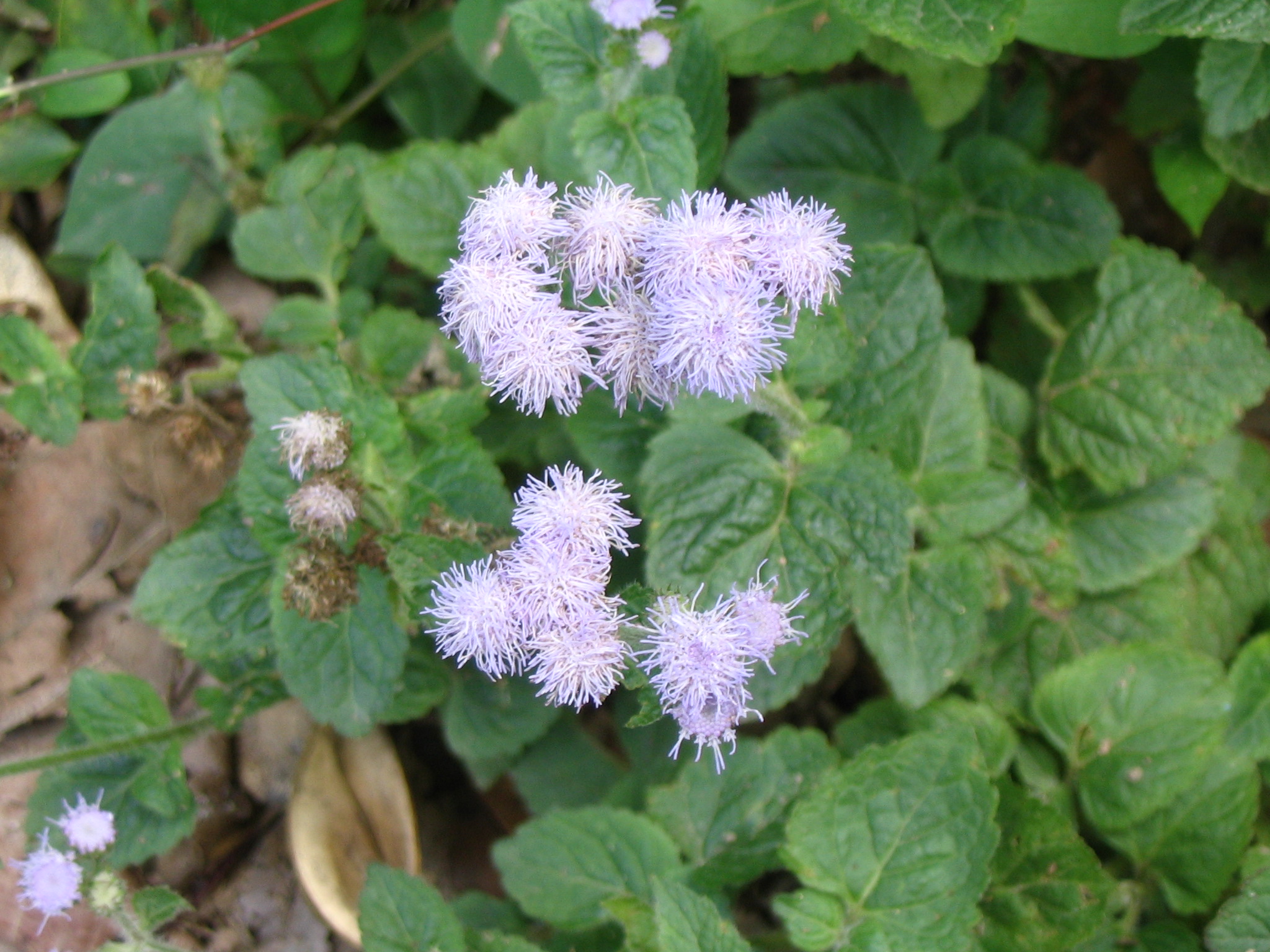Ageratum conyzoides

|
|
Ageratum conyzoides Common Names: Goat Weed, Billygoat Weed, White Weed,
Tropical Whiteweed Scientific
Classification Kingdom: Plantae Phylum: Tracheophyta Class: Magnoliopsida Order: Asterales Family: Asteraceae Genus: Ageratum Species: A. conyzoides Synonyms: Ageratum conycoides L., Ageratum obtusifolium Lam., Cacalia mentrasto Vell. Morphological Description Ageratum conyzoides, commonly known as Goat Weed, is an annual herbaceous plant,
typically growing 0.3–1 m tall, occasionally reaching 1.5 m. Its key features
include: · Stem: Erect, branched, slender, hairy, with fine white trichomes · Leaves: Opposite, ovate to rhomboid-ovate, 1–10 cm long, 0.5–7 cm
wide, green with purple tinges, pubescent, with crenate to serrate margins · Flowers: Small, tubular, 4–6 mm across, white to purple, in dense
terminal corymbs (5–15 heads), blooming year-round in tropics · Fruit: Black achene, 1–2 mm long, with an aristate pappus, wind-dispersed The plant’s aromatic,
goat-like odor and photoblastic seeds contribute to its widespread distribution
Distribution and Habitat Ageratum conyzoides is native to Central and South America but has spread
pantropically to Africa (Nigeria, Ghana, Cameroon), Asia (India, Indonesia,
Philippines), Australia, and the Pacific Islands. It thrives in: · Ecosystems: Disturbed areas, grasslands, open forests, roadsides, rice
fields, and cultivated lands · Climate: Tropical to subtropical, with rainfall of 500–2,500 mm
annually and temperatures of 20–35°C · Soils: Nutrient-rich, well-drained, loamy to sandy, tolerating poor
soils · Altitude: Sea level to 2,000 m Ethnopharmacology Ageratum conyzoides , commonly known as goat weed or billygoat-weed, is a
medicinal plant extensively used in traditional medicine across tropical and
subtropical regions. Different parts of the plant, especially the leaves,
flowers, and roots, are known for their antibacterial, antifungal,
anti-inflammatory, analgesic, antioxidant, antimalarial, and wound-healing
properties. Traditionally, it is used to treat wounds, skin infections, fevers,
diarrhea, dysentery, rheumatism, and respiratory ailments like coughs and
asthma. Extracts from the plant are also applied to stop bleeding and promote faster
wound closure. Phytochemical investigations have identified active compounds
such as alkaloids (notably pyrrolizidine alkaloids), flavonoids, saponins, and
terpenoids, which are believed to be responsible for its therapeutic effects.
Despite its wide traditional use, caution is advised, as some compounds,
particularly pyrrolizidine alkaloids, can be toxic if consumed in large
amounts. Further clinical research is needed to fully validate its medicinal
potential and ensure its safe use. · Anti-inflammatory Activity: Aqueous extracts
of Ageratum conyzoides
have been shown to inhibit inflammation by suppressing NLRP3 inflammasome
activation. The extract reduces levels of pro-inflammatory cytokines such as
IL-1β, IL-18, and TNF-α in activated macrophages (Xu et al., 2023). · Antimicrobial Properties: The plant
exhibits significant antimicrobial activity against a range of bacterial and
fungal pathogens, supporting its traditional use in treating infections
(Brojendro et al., 2013). · Analgesic and Antipyretic Effects: Essential oils
derived from A.
conyzoides have demonstrated pain-relieving and fever-reducing
properties in animal models (Brojendro et al., 2013). · Antioxidant Activity: Phytochemical
analyses have revealed the presence of flavonoids and phenolic compounds that
contribute to the plant's antioxidant capacity (Brojendro et al., 2013). · Anticancer Potential: Certain compounds
isolated from A.
conyzoides have shown cytotoxic effects against cancer cell lines,
indicating potential anticancer properties (Brojendro et al., 2013). · Insecticidal and Nematicidal Activities: The plant
contains precocenes and other terpenoids that exhibit insecticidal properties,
affecting the development of insect larvae and serving as a natural pesticide
(Global Invasive Species Database, n.d.). ⚠ Toxicity Profile: Despite its medicinal benefits, A. conyzoides
contains pyrrolizidine alkaloids such as lycopsamine and echinatine, which are
hepatotoxic and potentially carcinogenic. Ingestion of the plant has been
associated with liver lesions and tumors. A notable incident in Ethiopia
involved mass poisoning due to grain contamination with A. conyzoides
(Wikipedia, n.d.). However, a 90-day repeated dose oral toxicity study in rats
indicated that an alkaloid-free extract of A. conyzoides did not cause
mortality or toxic changes at doses up to 1000 mg/kg, suggesting that removal
of toxic alkaloids can mitigate adverse effects (Palmer et al., 2019). Additional Uses · Agricultural: Used as a biopesticide, with essential oils showing 100% mortality
against Aedes aegypti larvae
at 148 µg/L, and as a nematicide against Meloidogyne incognita in Nigeria · Ecological: Allelopathic chemicals inhibit neighboring plant growth,
contributing to its invasiveness; it supports pollinators like bees in disturbed
habitats · Industrial: Essential oils are explored for pharmaceutical and cosmetic
applications due to their antimicrobial properties References
External Links More Pictures |
|
| Compounds of Ageratum conyzoides | |
| References |